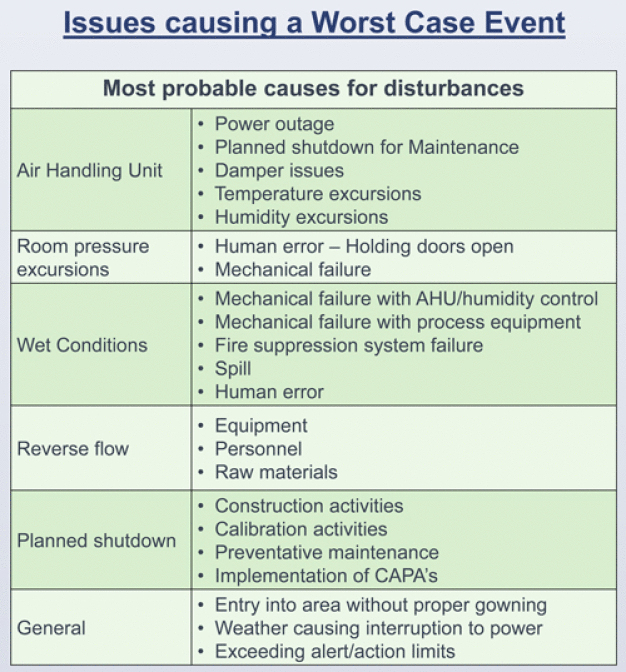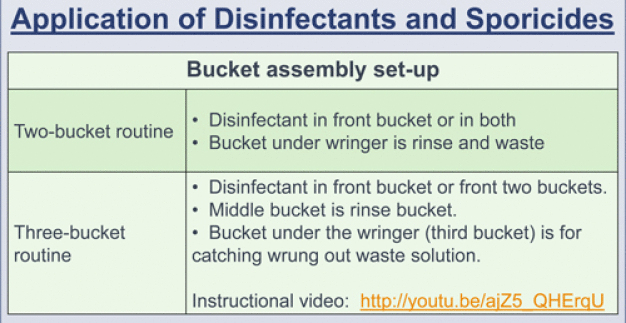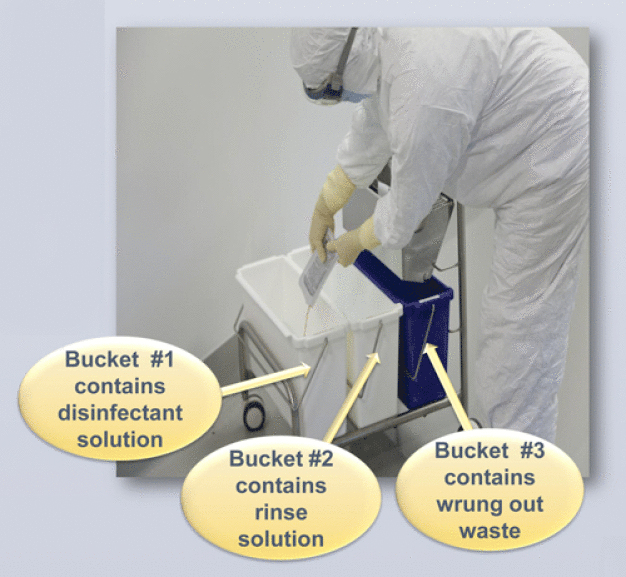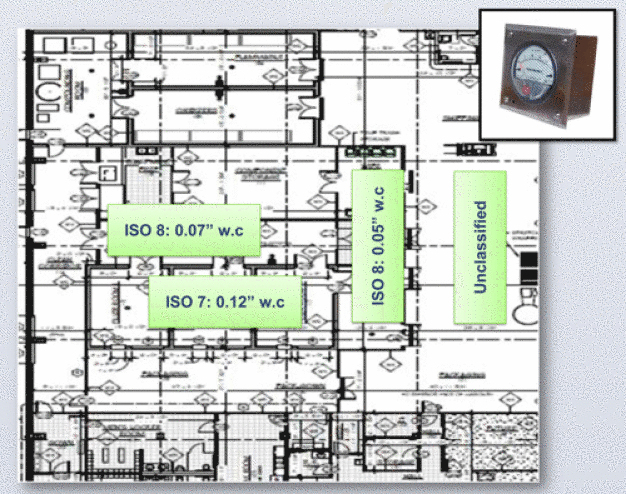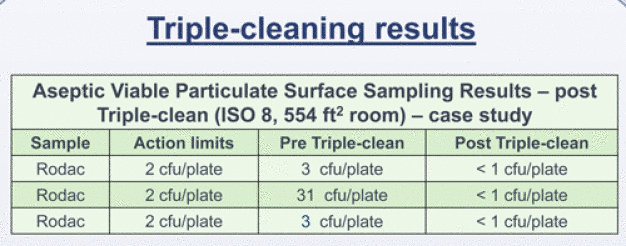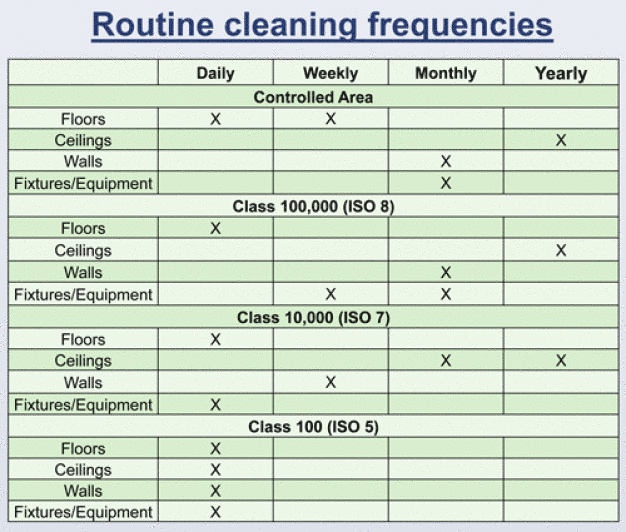Jim Polarine & Beth Kroeger
Bringing Cleanrooms Online, Initially and After a Worst Case Event
Introduction
Environmental control of classified areas within a biopharmaceutical facility is maintained by systems controlling humidity, air temperature, air exchanges, filtration and pressure differentials and by practices such as room cleaning, limited access and facility flow. When any of these systems or practices fail, it’s considered a “Worst Case Event” which has the potential to impact the clean state of a Classified Area.
Many facilities have procedures in place to conduct the day-to-day operations but fail to have procedures in place to handle catastrophic or non-routine events. These disturbances should be defined as part of the Facility Cleaning Procedures in order to provide guidance to operators if issues occur during off-shift or to provide a routine response to a non-routine event. (see fig. 1: Issues causing a Worst Case Event)
Is action always necessary?
Not always. Air handling unit (AHU) shutdowns and pressure differentials excursions should have procedures in place for when events occur. Facilities should determine the amount of time a door may be open to not impact the pressures. Facilities should also establish a time limit that pressure differentials are allowed outside of the established range along with how long AHU shutdown is acceptable without requiring a major clean and Environmental Monitoring. Acceptance criteria should include conditions such as no traffic in the room, doors remaining shut and time limit for pressure excursions or AHU shutdown.1
Procedures should define the most probable excursions and place acceptable criteria around such incidents so when an event does occur, there are some parameters in place to provide alternative responses that have been thought out and verified in advance.
Immediate Actions
- Isolate the area.
- Notify appropriate personnel.
- Limit personnel working in the area. If access is required, change shoe covers, when exiting the area, to avoid contaminating adjacent area.
- Clean or cover equipment and materials as they are transported out of the area.
- Clean the area impacted by the event by first clearing any spill or debris using a HEPA wet/dry vacuum or other appropriate means such as wipes, mops or squeegees.
- Triple-clean the area.
Triple-clean – What is it?
- No unified definition
- PDA Technical Report: “Facilities should strongly consider having special start-up cleaning and disinfection programs in place following “shutdowns” or when significant construction is performed.”2
1. Triple-clean definition:
Application of a disinfectant, followed by another application of a disinfectant using fresh solution and bucket/mop assemblies, followed by an application of a sporicidal agent.
2. 9 X clean:
Performing a triple-clean each day on 3 consecutive days.
Application of Disinfectants and Sporicides
(see fig. 2)
Application technique
- Dip mop head into front bucket (bucket #1), let excess liquid drain off or wring. Apply to the surface.
- When mop head appears to be dragging on the surface, dip into rinse bucket (bucket #2), then wring out waste into bucket #3.
- Repeat.
- Change out the use dilutions every 600 ft2 in ISO 5 and 1,000 ft2 in an ISO 6, 7 and 8.
- Mop in a grid pattern.
- Mop top to bottom and back to front.
- Unidirectional application.
- Overlap application by 20%. (see picture 1)
New Cleanroom Operation
New Clean-rooms should be Certified following International Standard (ISO) 14644-2, Cleanrooms and associated controlled environments, Part 2: Specifications for testing and monitoring to prove continued compliance with ISO 14644-1.
Requirements for Certification
1. Particle concentration limits, which ensures the Classification of the cleanroom.3,4
2. Airflow volume or airflow velocity.3,4
3. Room differential pressures.3,4
4. HEPA filter Integrity leak tests and efficiency tests.3,4 (optional)
5. Smoke studies, including a video of smoke patterns. 3,4 (optional)
6. Laminar flow hood or Biological Safety Cabinet certification, if required.
Cleanroom specifications
- 30 – 60% relative humidity
- 16 – 24°C
- Air change rate: ISO 8: >20 air changes per hour, ISO 7: >50 air changes per hour
- Positive differential pressure 10-15 pascals (12.5 pas = 0.05 inches of water column (“w.c.)) between adjacent areas of different classifications.5
- Pressure differential of 0.02”w.c. between adjacent clean spaces.6 (see pict. 2)
What cleaning is required for Certification?
1. Removal of construction debris: Remove debris, corrugate and unnecessary items.
2. Vacuum and then wipe or mop all surfaces: Use approved disinfectants, utensils and assemblies
3. Uncover/expose air returns. At this point in new construction, the air returns may have been covered by the contractors as a precaution.
- Non-invasive construction work may still be in progress.
- Certify while construction activities are ending with personnel on site to remediate issues, if discovered.
- It’s not necessary to have cleanrooms 100% operable with full gowning, routine cleaning and Environmental Monitoring implemented.
- A triple-clean may be performed, however, it’s not necessary for Certification. The goal should be to remove particulates in order not to obstruct the filters when the system is in operation.
Triple-cleaning results
(see fig. 3)
General Recommendations
- No cleaning should take place in an area during open operations and/or during environmental monitoring.
- Rooms divided by lines of demarcation, separating two classes in the same room should be cleaned and monitored per the stricter classification.
- Do not use solutions and equipment from a less strict classification to clean a stricter classification of room.
Routine cleaning frequencies
(see fig. 4)
Summary
Worst case event response should be detailed as part of the Facility Cleaning Standard Operating Procedures. Action is not always necessary, provided there are proven acceptable limits and procedures surrounding AHU shutdowns and pressure differential excursions. When an event occurs that requires action, rooms should be isolated with personnel access to the area restricted and additional gowning procedures in place to avoid contaminating adjacent areas. Area should be triple-cleaned after a worst case event and monitored prior to release of room. New cleanrooms should meet ISO 14644-2 requirements, however, new construction cleaning is more concerned with particulate removal rather than microbial control for certifcation. Final triple-clean prior to room release is required along with environmental monitoring and Quality release of room based on micro results.
References
1. Anderson C. and Lloyd B. (2014) Evaluation of Controlled Manufacturing Environments following an Air Handling Unit Shutdown. Pharmaceutical Engineering. 34 (1).
2. PDA, Technical Report (Draft 2015), Fundamentals of Cleaning and Disinfection Programs for Aseptic Manufacturing Facilities.
3. International Standard (ISO) 14644-2, Cleanrooms and associated controlled environments, Part 2: Specifications for testing and monitoring to prove continued compliance with ISO 14644-1. (2000)
4. International Standard (ISO) 14644-3, Cleanrooms and associated controlled environments, Part 3: Test methods. (2005)
5. FDA Guidance for Industry, Sterile Drug Products Produced by Aseptic Manufacturing – Current Good Manufacturing Practice. Sep. 2004, p. 11.
6. Schneider, R.K. (2012) Why do Cleanrooms Fail to Meet Owners Expectations? Controlled Environments Magazine. April 2012.
STERIS Deutschland GmbH
50933 Köln
Germany





